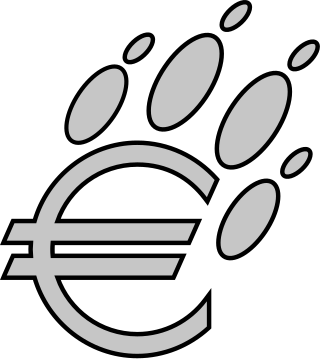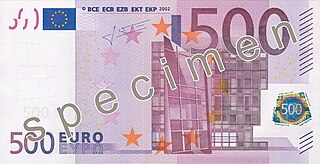A currency is a standardization of money in any form, in use or circulation as a medium of exchange, for example banknotes and coins. A more general definition is that a currency is a system of money in common use within a specific environment over time, especially for people in a nation state. Under this definition, the British Pound sterling (£), euros (€), Japanese yen (¥), and U.S. dollars (US$) are examples of (government-issued) fiat currencies. Currencies may act as stores of value and be traded between nations in foreign exchange markets, which determine the relative values of the different currencies. Currencies in this sense are either chosen by users or decreed by governments, and each type has limited boundaries of acceptance; i.e., legal tender laws may require a particular unit of account for payments to government agencies.

The euro is the official currency of 20 of the 27 member states of the European Union. This group of states is officially known as the euro area or, more commonly, the eurozone. The euro is divided into 100 euro cents.

In economics, cash is money in the physical form of currency, such as banknotes and coins.
Seigniorage, also spelled seignorage or seigneurage, is the difference between the value of money and the cost to produce and distribute it. The term can be applied in two ways:

The Canadian dollar is the currency of Canada. It is abbreviated with the dollar sign $. There is no standard disambiguating form, but the abbreviations Can$, CA$ and C$ are frequently used for distinction from other dollar-denominated currencies. It is divided into 100 cents (¢).

The króna or krona is the currency of Iceland. Iceland is the fifth-smallest country by population, after Vanuatu, Barbados, Tonga and the Seychelles, to have its own currency and monetary policy.
Federal Reserve Notes are the currently issued banknotes of the United States dollar. The United States Bureau of Engraving and Printing produces the notes under the authority of the Federal Reserve Act of 1913 and issues them to the Federal Reserve Banks at the discretion of the Board of Governors of the Federal Reserve System. The Reserve Banks then circulate the notes to their member banks, at which point they become liabilities of the Reserve Banks and obligations of the United States.

A banknote—also called a bill, paper money, or simply a note—is a type of negotiable promissory note, made by a bank or other licensed authority, payable to the bearer on demand. Banknotes were originally issued by commercial banks, which were legally required to redeem the notes for legal tender when presented to the chief cashier of the originating bank. These commercial banknotes only traded at face value in the market served by the issuing bank. Commercial banknotes have primarily been replaced by national banknotes issued by central banks or monetary authorities.

Legal tender is a form of money that courts of law are required to recognize as satisfactory payment for any monetary debt. Each jurisdiction determines what is legal tender, but essentially it is anything which when offered ("tendered") in payment of a debt extinguishes the debt. There is no obligation on the creditor to accept the tendered payment, but the act of tendering the payment in legal tender discharges the debt.

EuroBillTracker (EBT) is a website designed for tracking euro banknotes. It was inspired by the US currency bill tracking website Where's George? The aim is to record as many notes as possible to know details about their distribution and movements, follow it up, like where a note has been seen in particular, and generate statistics and rankings, for example, in which countries there are more tickets. EuroBillTracker has registered over 220 million notes with a combined total value of more than €4 billion as of September 2023.

The Lithuanian litas (ISO currency code LTL, symbolized as Lt; plural litai or litų was the currency of Lithuania, until 1 January 2015, when it was replaced by the euro. It was divided into 100 centų. The litas was first introduced on 2 October 1922 after World War I, when Lithuania declared independence, and was reintroduced on 25 June 1993 following a period of currency exchange from the Soviet ruble to the litas with the temporary talonas then in place. The name was modeled after the name of the country. From 1994 to 2002, the litas was pegged to the U.S. dollar at the rate of 4 to 1. The litas was pegged to the euro at the rate of 3.4528 to 1 since 2002. The euro was expected to replace the litas by 1 January 2007, but persistent high inflation and the economic crisis delayed the switch.

The North American monetary union is a theoretical economic and monetary union of three North American countries: Canada, Mexico, and the United States.
Where's Willy? is a website that tracks Canadian paper money, most commonly $5 bills, but also higher denominations. "Where's Willy" is free, supported by users who pay a fee for extra features. The name Willy refers to Sir Wilfrid Laurier - the seventh Prime Minister of Canada whose portrait appears on the $5 banknote.
The Irish Free State, subsequently known as Ireland, resolved in the mid-1920s to design its own coins and banknotes. Upon issuing the new currency, the Free State government pegged its value to the pound sterling. The Currency Act, 1927 was passed as a basis for creating banknotes and the "Saorstát pound" as the "standard unit of value." The legal tender notes issued under this act began circulating on 10 September 1928.
This page is a glossary of notaphily. Notaphily is the study of paper money or banknotes.

Where's George? is a website that tracks the natural geographic circulation of American paper money. Its popularity has led to the establishment of a number of other currency tracking websites and sites that track other objects, such as used books. Statistics generated by the website have been used in at least one research paper to study patterns of human travel in the United States.

Banknotes of the euro, the common currency of the eurozone, have been in circulation since the first series was issued in 2002. They are issued by the national central banks of the Eurosystem or the European Central Bank. The euro was established in 1999, but "for the first three years it was an invisible currency, used for accounting purposes only, e.g. in electronic payments". In 2002, notes and coins began to circulate. The euro rapidly took over from the former national currencies and slowly expanded around the European Union.

The five-euro note (€5) is the lowest value euro banknote. It has been used since the introduction of the euro in 2002. The note is used in the 25 countries that have it as their sole currency, which countries have a total population of about 343 million currently. In July 2023, there were approximately 2,159,000,000 five-euro banknotes in circulation around the eurozone. It is the fifth-most widely circulated denomination, accounting for 7.2% of the total banknotes. Estimates suggest that the average life of a five-euro banknote is less than a year before it is replaced due to wear.
Slang terms for money often derive from the appearance and features of banknotes or coins, their values, historical associations or the units of currency concerned. Within a language community, some of the slang terms vary in social, ethnic, economic, and geographic strata but others have become the dominant way of referring to the currency and are regarded as mainstream, acceptable language.

The five-hundred-euro note (€500) is the highest-value euro banknote; it was produced between the introduction of the euro in 2002 until 2019. Since 27 April 2019, the banknote has no longer been issued by central banks in the euro area, but it continues to be legal tender and can be used as a means of payment. It is one of the highest-value circulating banknotes in the world, worth around 535 USD; 3,874 CNY; 83,598 JPY; 426 GBP, or 487 CHF as of April 2024. The note is used in the 26 countries which have the euro as their sole currency, with a population of about 343 million.












